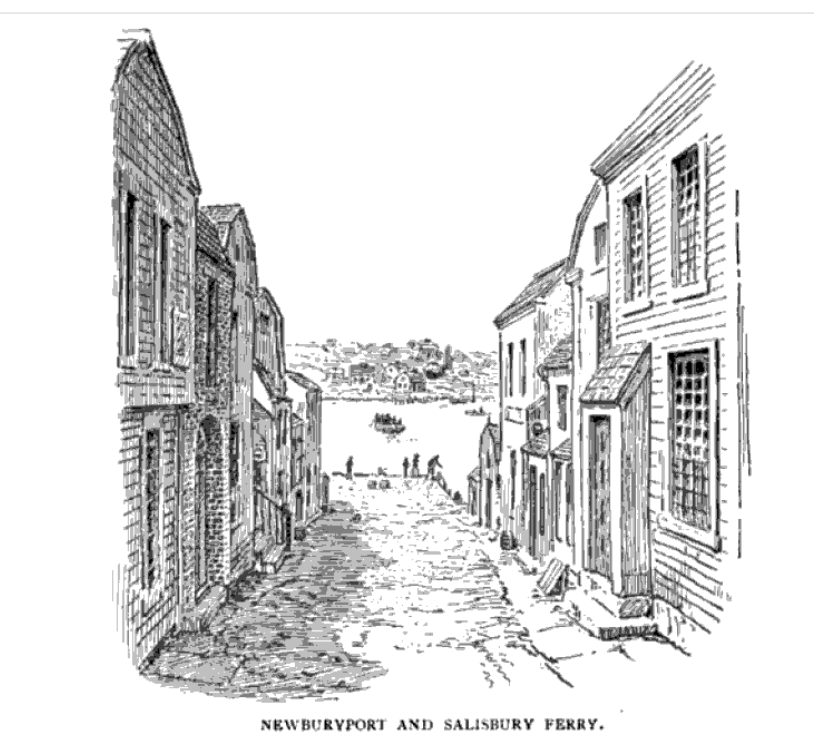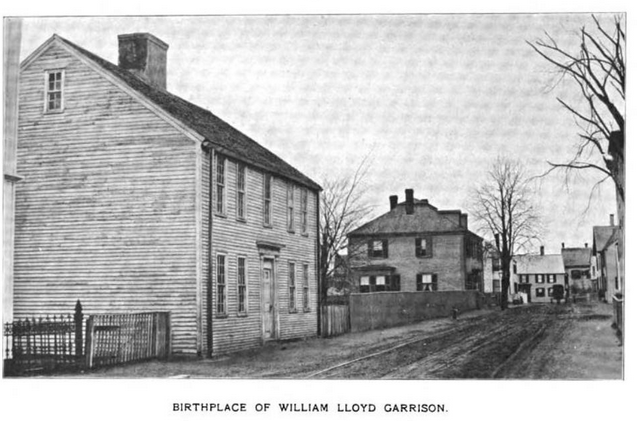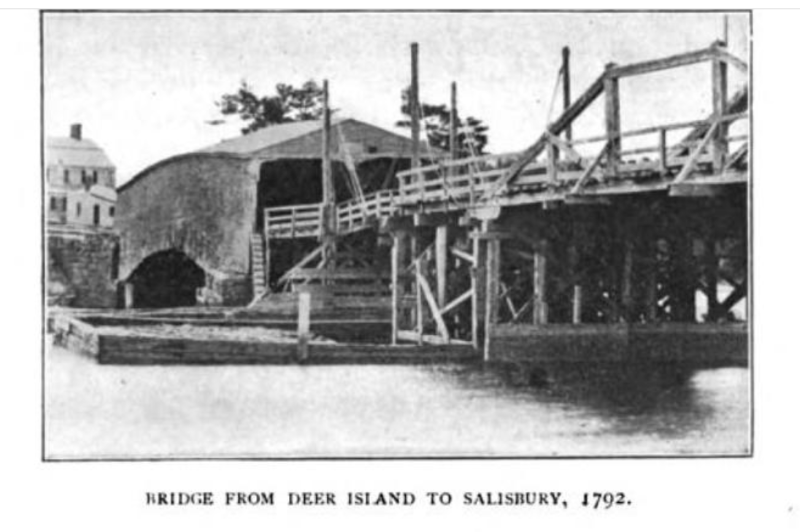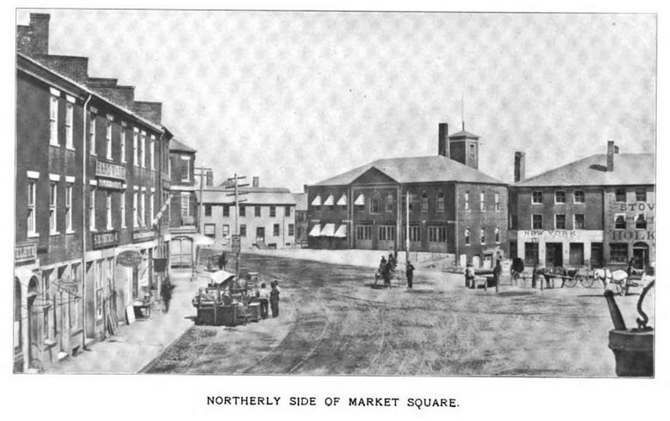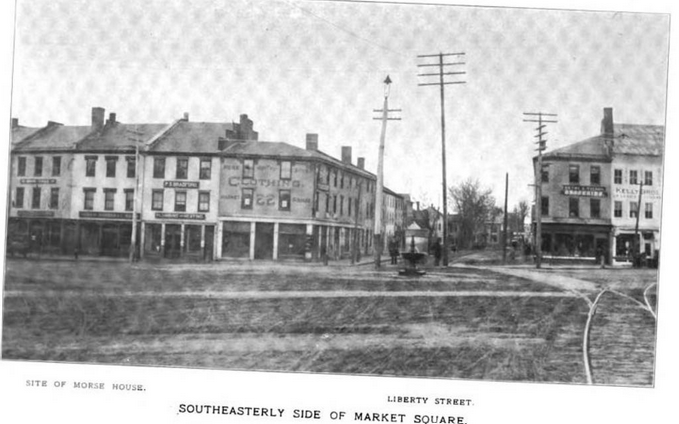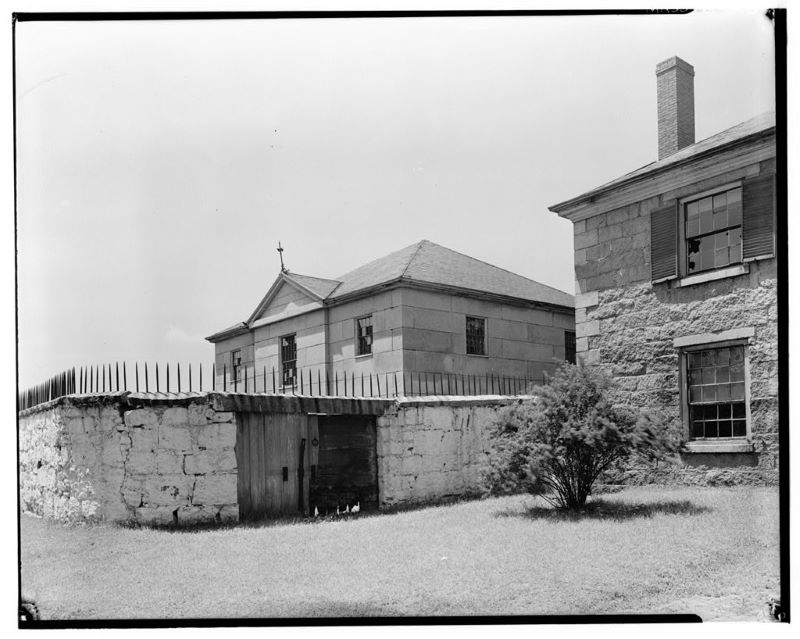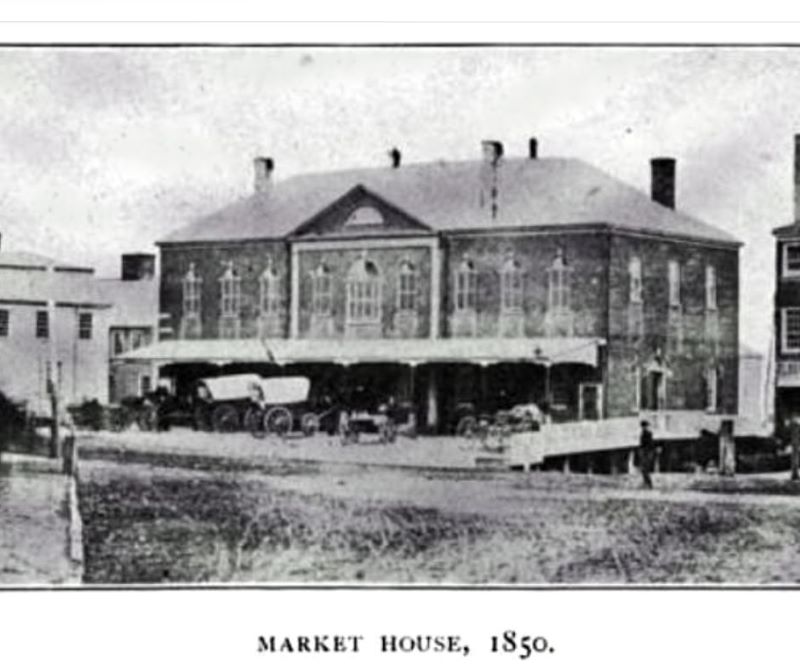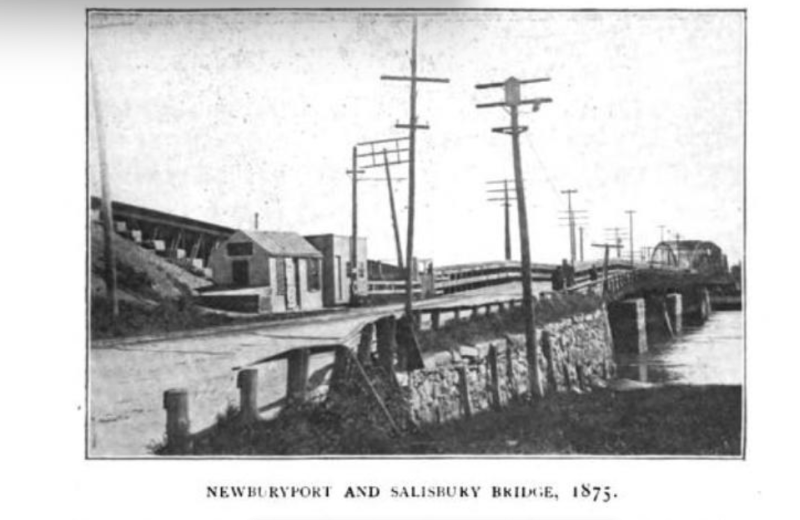Newburyport is a historic town in Essex County in Massachusetts. It was originally occupied by the Penacook tribe before being settled by English colonists in the early 17th century.
The following is an overview of the history of Newburyport:
Pre-colonization:
- Local Penacook tribe members often meet early explorers from England, France and Holland on the banks of the Merrimack River, near modern day Market Square, to trade furs and fish.
- Newburyport is the starting point of a major north/south Native American trail which ran along the Middle Street and State Street Area.
1620s – 1630s:
- A trading station is established in what is now Market Square.
1633:
- As early as 1633, some hunters and fishermen establish themselves on the Merrimack River to hunt and fish.
- Sometime in the early 1630s, an English trader, who the local Native Americans call “Great Walt” or “Great Watt,” builds a house by a rocky outcrop on the river at the foot of modern day State Street in Market Square. The cellar of the house, which comes to be known as Watt’s cellar, is the only thing that eventually survives but it becomes lost over time. The cellar is the oldest documented structure in Newburyport and the Merrimack River Valley but it still cannot be located and is believed to have been destroyed as a result of construction in the area in the 19th century.
1635:
- Newburyport is first settled as a part of Newbury.
1639:
- The General Court orders a road laid out between Ipswich and Newbury and names it Bay Road.
- A meetinghouse is built somewhere south of what is now Curzon Mill Road.
1641:
- George Carr establishes a ferry at the end of Bay Road on the Merrimack River.
1645:
- Fish Street is laid out and is later renamed State Street in 1725.
1649:
- South Street, High Street, Merrimac Street, Woodland Street and Merrimack Court are laid out sometime around 1649 or slightly after.
- A wharf is built on the Merrimack River to service Carr’s ferry.
1651:
- Edward Rawson sells his house, now known as the Rawson – Pillsbury house, on High Street to William Pillsbury.
1655:
- The small, rocky parcel of land along the Merrimack River, at the foot of what is now State Street, is granted to Captain Paul White who builds the first wharf in Newburyport there.
- Coffin’s Lane is laid out and is later renamed Jefferson Street.
1660:
- The Jacob Toppan House, a Colonial-style house, is built by Jacob Toppan on what is now Toppan’s Lane. The land at the time was owned by Toppan’s father-in-law Henry Sewall and was inherited by Toppan when Sewall passed in 1678.
1675:
- The population of Newburyport is about 300.
1678:
- Curzon’s Mill House, a mill house with two turbine water wheels, is built by John Emery on Curzon’s Mill Road.
1680:
- The Titcomb house, a Colonial-style saltbox house, is built on what is now Green Street. The house is later moved to Ipswich.
1695:
- The Sawyer Hill Burying Ground is established on Curzon Mill Road.
1696:
- The meetinghouse near Curzon Mill Road is enlarged and a burial ground is established next to it.
1700:
- The George Thurlow – B. Pettingill House is built at what is now 2 Neptune Street. Portions of the house may have been built as early as the 1650s.
- The John Weed House, a Colonial-style house, is built by John Weed on High Street.
- The Cobby House, a Colonial-style house, is built sometime around 1700 on Low Street.
- The Charles Hale House, a Colonial-style house, is built sometime around 1700 on Marlboro Street.
- The Benjamin Coker House, a First Period clapboard house, is built sometime around 1700 on High Street.
- The Charles W. Hale House, a First Period clapboard house, is built sometime around 1700 on Marlboro Street and was later purchased by Charles W. Hale in the the late 19th century.
1710:
- The Elias Todd House, a Georgian-style house, is built sometime around 1710 on Beck Street and is later purchased by Elias Todd in 1851.
1720:
- The Belleville Cemetery is established on Storey Avenue.
1729:
- The Old Hill Burying Ground is established on Greenleaf Street next to the Bartlett Mall.
1742:
- St. Paul’s Cemetery is established on the corner of High Street and Market Street.
1743:
- The Newburyport Quaker Meetinghouse, a Georgian-style two story meetinghouse, is built on High Street in the North End.
1744:
- The Old Newbury Jail is built on Federal Street.
1746:
- The Dalton House, a Georgian-style house, is constructed for Michael Dalton at 95 State Street.
1750:
- A Colonial-style house is built on School Street and later becomes the birthplace of William Lloyd Garrison in 1805, earning it the name the William Lloyd Garrison birthplace.
1754:
- A powder house is built on the town mall.
1756:
- The Old South Church, a Georgian-style church building, is built on Federal Street.
1758:
- Shipbuilder Ralph Cross builds the first bridge over the Parker River, known as the Parker River Bridge, on what is now High Road.
1759:
- William Davenport returns home from the French and Indian War and opens the Wolfe Tavern in a converted house on Fish Street (now State Street.) Davenport names the tavern after General Wolfe who was killed in the French and Indian War that year.
1762:
- The Town Hall building, a wooden municipal building, is constructed at 47 State Street.
1764:
- Newburyport is incorporated as a town in the Province of Massachusetts Bay.
- The population of Newburyport is 2,882 and the town has 357 houses.
1771:
- The Nathaniel Tracy House, a three-story Georgian-style brick building, is constructed by Captain Patrick Tracy for his son Nathaniel Tracy at 94 State Street. The estate extends to Green Street and features gardens, fruit orchards and barn stables.
- The Jackson-Dexter House, a Federal-style mansion, is built on High Street for local merchant Jonathan Jackson.
1773:
- Residents protest the Tea Act of 1773 by burning British tea in Market Square.
1775:
- On April 7, local businessman Francis Cabot Lowell is born in Newboryport.
1780:
- The Captain Anthony Gwynne Commercial Building is constructed at 65 Water Street.
1783:
- Orange Street is laid out between Fair Street and Federal Street.
1785:
- The First Presbyterian Society Parsonage, a Georgian-style house, is built on Orange Street.
1790:
- The Newburyport North High School, a Federal-style wooden school house, is constructed on the Bartlett Mall.
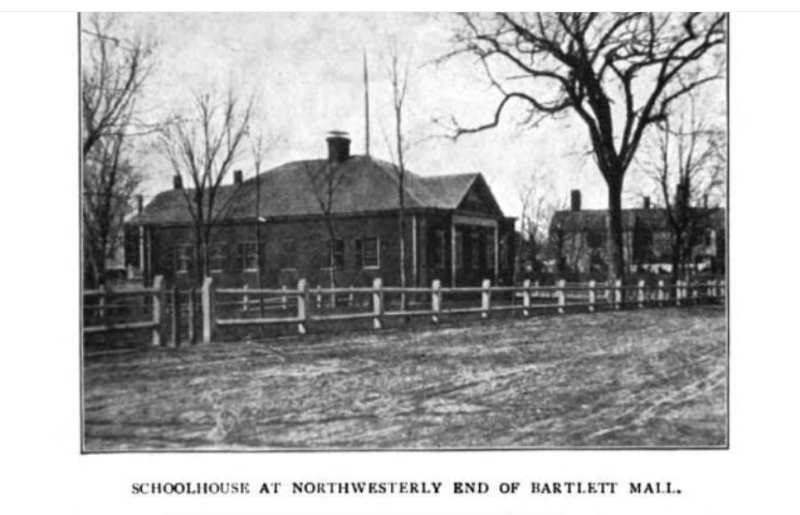
- The population of Newburyport is 4,837.
1791:
- The first ship of the United States Revenue Cutter Service, the USRC Massachusetts, is built in Newburyport, making it the birthplace of the Coast Guard.
1792:
- A wooden bridge is built by Timothy Palmer over the Merrimack River on Main Street to Deer Island.
1794:
- A brick almshouse is built on Prospect Street.
1796:
- The Second Presbyterian Meeting House, a Federal-style building, is constructed on Harris Street.
- The Pawtucket Canal is completed, linking the Merrimack River with inland factory towns like Lowell and Waltham, which establishes Newburyport as a trading center for much of interior New England.
1800:
- The Highland Cemetery in established on Hill Street.
- The Bartlett Mall is constructed on High Street.
- Brown’s Wharf, a Federal-style warehouse, is constructed on Green Street.
- The North Row Building, a Georgian/Federal-style brick commercial block, is constructed at 4-10 Market Square.
- The Jacob Balch – Dudley Batchelder Building, a Federal-style building, is constructed at 140-142 Merrimac Street and later serves as a grocery store in 1851.
- The Merchants National Bank Building, a brick Federal-style commercial building, is constructed at 59-61 State Street.
- The population of Newburyport is 5,946.
1801:
- The Church of the First Religious Society, a Federal-style church building, is constructed on Pleasant Street.
1802:
- Brown Square Park is established in Brown Square.
1805:
- The Newburyport Superior Courthouse, a Federal/Italianate-style building designed by architect Charles Bullfinch, is built on High Street.
- On December 10, William Lloyd Garrison is born in Newburyport.
1806:
- On October 23, 1806, local eccentric businessman and author, Lord Timothy Dexter, dies at the age of 59 at his mansion, the Jackson-Dexter House, on High Street and is later buried in the Old Hill Burying Ground.
1807:
- The Newburyport Academy, a Federal-style building that serves as a private school, is built on High Street and opens on October 20.
1808:
- The Quaker Cemetery is established on Turkey Hill Road.
1809:
- The Perkins Printing and Engraving Plant is constructed on High Street.
- The Davenport Building, a Federal-style brick commercial building, is constructed at 11-13 Market Square.
- The Phoenix Building, a commercial building designed by architect Charles Bullfinch for the Phoenix Marine and Fire Insurance Company, is constructed at 18-26 State Street.
1809 – 1810:
- Four brick Federal-style townhouses are built by Moses Brown at Brown Square. The townhouses are later converted into a boarding house sometime before 1849 and then serve as the Garrison Inn until it closes in 1949.
1810:
- The wooden bridge on Main Street to Deer Island is replaced by a wrought iron chain suspension bridge.
- The Town Hall building at 47 State Street is demolished and replaced by a brick townhouse that serves as a town hall, court house, police station and town offices.
- Brown’s Wharf is built on Merrimac Street.
- The population of Newburyport is 7,634.
1811:
- The Great Fire of 1811 breaks out, destroying around 250 of the wood frame buildings in the downtown area including all of the buildings in Market Square and on State Street, such as the Wolfe Tavern.
- The East Row Building, a Federal-style brick commercial building, is constructed at 14-22 Market Square after the fire.
- The West Row Building, a Federal-style brick commercial building, is constructed at 31-35 Market Square after the fire.
- The Justin Smith and Rufus Grocery Store – Adams House, a Federal-style brick commercial block, is built at 36-38 Market Square. The building later served as a grocery store in 1816 and the eastern part of the block was a part of the Adams House Hotel.
- The Charles House – Joseph Akeman Building, a Federal-style brick commercial building, is constructed at 3-7 Middle Street and later serves as a saloon, restaurant and billiards room in the 1870s.
- The Towle and Jones Silversmith Shop, a Federal-style brick commercial building, is constructed at 9-15 Middle Street and later becomes home to the Ladies and Gents Eating and Oyster House after the Civil War and then Leary’s Lunch, Liquors and Restaurant/Pilot House restaurant in the 1930s before being renamed the Grog in 1969.
- The Phoenix Building, a Federal-style brick building, is rebuilt at 18-26 State Street.
- The Marine Society Building, a Federal-style brick building, is constructed at 10-16 State Street and is later purchased by the Marine Society in 1851.
- The Grant Club, a Federal-style brick commercial building, is constructed at 38 State Street.
- The Nathaniel Horton Shoe Shop, a Federal-style brick commercial building, is constructed at 42-44 State Street.
- The Eaton Drug Building, a Federal-style brick commercial building, is constructed at 58 State Street and was later occupied by Eaton’s Drug Store in 1922.
1814:
- The Wolfe Tavern reopens on the corner of State Street and Harris Street.
1815:
- Dugan’s Building, a Federal-style brick commercial building, is constructed at Market Square.
- The Ferry Wharf Building, a Federal-style brick commercial building, is constructed at 1-5 Water Street.
1818:
- Inn Street is laid out in downtown Newburyport as part of the reconstruction effort after the fire of 1811.
- The Adams House Hotel – B. G. Sargent Oyster Saloon, a Federal-style brick commercial block, is built at 4-8 Inn Street. The block was home to an oyster saloon, liquor store and a hotel in the mid to late 19th century.
- The Josiah R. Brady Cigar Factory, a Federal-style brick commercial block, is built at 12-16 Inn Street.
- The Charles Daniel Boot and Shoe Store, a Federal-style brick commercial block, is built at 18-22 Inn Street.
- The Abraham Ray Saloon – Solomon Schmidt Tailor shop, a Federal-style brick commercial block, is built at 24-26 Inn Street. The building was later home to the saloon and tailor shop in the 1880s and 1890s.
1820:
- The Fowle’s News shop building, a Federal-style brick commercial building, is constructed on State Street and originally serves as a tailor shop until Fowle’s news shop moves to the building in 1900.
- The Charles Sargent Machine Shop and Gunsmith, a Federal-style brick commercial building, is constructed at 43-47 Merrimac Street.
- The Central Labor Union Hall is constructed on State Street. The first floor serves as commercial space and the second floor serves as a meeting hall.
- The Diamond Block, a Federal-style brick commercial block, is constructed at 25-27 State Street.
- Cushing’s Wharf is constructed at 49 Water Street.
- Cushing’s Wharf Mercantile building and warehouse are built at Cushing’s Wharf on Water Street.
- The population of Newburyport 6,852.
1821:
- The South Row Building, a Federal-style brick commercial building, is constructed at 23-26 Market Square.
1822:
- Godfrey’s Hill Powder House is built on Low Street.
- The Swasey Sumner and Currier Building, a Federal-style commercial building, is constructed at 45 Water Street.
- A Native American grave is discovered on Market Street. A tomahawk, pipe and whetstones are found in the grave with the skeleton.
1823:
- The wooden school house is moved from the Bartlett Mall to 18 Center Street to be used as a private residence.
1824/5:
- A Newbury Old Stone Jail is built on Auburn Street.
- The Newburyport Jailkeeper’s House, a Georgian-style house. is built on Auburn Street.
1825:
- The Old Market House, a Federal-style brick building, is built at 1-3 Market Square. The building was originally a marketplace but later serves as a Lyceum hall in the 1830s, then became a police station and city jail in the 1850s and then became the Central Fire Station in the 1860s.
- The Frothingham Store, a Georgian-style house, is built on Market Street and serves as a grocery store.
- The People’s United Methodist Church, a Renaissance Revival-style, is constructed on Purchase Street.
1827:
- On February 6, after a heavy snowfall and extremely cold conditions, the suspension bridge on Main Street to Deer Island collapses into the river when a heavy oxcart with a team of six oxen and two horses attempts to cross it. The men and horses swim to shore but the oxen drown in the Merrimack River. The suspension bridge is rebuilt that summer.
1830:
- The Old Newbury Town House, an Italianate-style house, is built on Brown Street.
- The Gunnison Building, a brick commercial block, is constructed at 19-23 Water Street.
- The population of Newburyport is 6,375.
1832:
- The John Q. Adams Provisions Store, a Federal-style brick commercial block, is built at 5-7 Liberty Street.
1835:
- The United States Custom House, a Classical Revival-style granite customs house designed by architect Robert Mills, is built at 25 Water Street.
1840:
- The Bartlett Steam Mills Counting House, a brick commercial building, is constructed on Pleasant Street.
- The Alexander Block, a Colonial-style brick commercial block, is constructed on Pleasant Street.
- The population of Newburyport is 7,161.
1842:
- The Oak Hill Cemetery is established on State Street.
- The James Steam textile mill, a four-story brick factory building, is built on Charles Street.
1843:
- A shipyard is constructed at the foot of Ashland Street.
1845:
- The Ocean Steam Mills Worker Housing building, a Greek Revival-style building, is constructed on Munroe Street and serves as a boarding house for the factory.
- The James Blood Speculative Mill Worker Housing is constructed on Monroe Street.
- The Albert Currier Block, a Greek Revival-style brick rowhouse, is built on Munroe Street and serves as housing for the Ocean Steam Mills.
1847:
- The Green Street Baptist Church, a Gothic Revival-style church building, is constructed on Green Street.
1848:
- The Fiske Memorial Chapel, a Greek Revival-style church building, is constructed on High Street.
1850:
- The Albert Russell and Son Iron Foundry, a brick commercial building, is built on Merrimac Street.
- The population of Newburyport 9,572.
1851:
- The Perley Machine Shop – Prichard House, a Victorian eclectic-style brick commercial building, is constructed on Market Street.
- Newburyport City Hall, an Italianate-style building, is constructed on Pleasant Street and the old town hall on State Street is renamed Washington Hall.
- The Caldwell Rum Company builds a distillery at Caldwell’s wharf.
- A large section of Newbury is annexed to Newburyport.
- Newburyport is incorporated as a city in the Commonwealth of Massachusetts.
1853:
- The Davenport School is built on Congress Street.
- An Italianate-style brick commercial building is constructed at 57 State Street is later purchased by the Grand Army Republic, an organization for Civil War veterans, in 1877.
1855:
- Albion Hall, a Victorian Eclectic-style commercial building, is constructed at 33 State Street.
- Essex Hall, an Italianate-style commercial building, is constructed at 35-41 State Street.
1856:
- The Benjamin Coker House is moved to State Street.
- The Immaculate Conception Church, a Gothic Revival-style church, is built on Green Street.
1857:
- The Newburyport Quaker Meetinghouse is moved to Ferry Road.
1860:
- The Newburyport Engine House No. 7, a Victoria Eclectic-style building, is constructed on Forrester Street for use as a school and only later became an engine house.
- The Newburyport Mechanic No. 2 Fire House, an Italianate-style building, is constructed at 85 Water Street.
- The Jacob T. Shoe Building, a Greek Revival-style building that served as a shoe factory, is constructed on High Street.
- The population of Newburyport is 13,401.
1861:
- The Central Congregational Church, an Italianate-style church, is constructed on Titcomb Street.
1863:
- The Saint Anna’s Chapel is built on High Street.
1865:
- Local businessman Stephen Fowle opens his first news shop at 11 State Street.
- The Nathaniel Tracy House is renovated to serve as the town library.
- The First Methodist Episcopal Church is constructed at 53 Washington Street and is later sold to the Congregation Ahavas Achim to serve as a synagogue.
1866:
- The Merrimack Arms Manufacturing Company building, an Italianate-style brick factory building, is constructed on Merrimac Street and is later acquired by the Towle Manufacturing Company in 1883.
1867:
- The Belleville Congregational Church, a Romanesque Revival-style church building, is constructed on High Street.
1870:
- Horse-powered street cars are established in Newburyport.
- The population of Newburyport is 12,595.
1872:
- The Old Newbury Town House is converted into the Brown High School.
- The Kelley School, an Italianate-style brick school building, is constructed on High Street.
- The Newburyport Institution for Savings, an Italianate-style building, is constructed at 93 State Street.
1873:
- The Newburyport Harbor Front Range Light and Rear Range Light are constructed on Water Street.
- The E.P. Dodge Building, an Italianate-style brick factory building, is constructed at 19-23 Pleasant Street and serves as a shoe manufacturing factory.
- The First Religious Society Parish Hall, a Federal-style building, is built on Pleasant Street.
- The Central Building, an Italianate-style building, is constructed on Pleasant Street.
- Fowle’s news shop moves to a bigger location at 13 State Street.
- The Mooney Block, an Italianate-style brick commercial block, is constructed at 35-41 Water Street.
- On May 23, a steam locomotive smashes through the barriers of a dead end side track on the Eastern Railroad line and falls down the embankment to Merrimac Street below.
1874:
- The Newburyport Five Cent Savings Bank is constructed on 71-75 State Street.
1875:
- St. Mary’s Cemetery is established on Storey Avenue.
1876:
- The Caldwell Distillery Warehouse, a Victorian-style brick warehouse, is built by the Caldwell Rum Company at 200 Merrimac Street. A wooden distillery building was also built on the property but it was later destroyed in a fire.
- The George H. Plumer Building, an Italianate-style brick commercial building, is constructed at 70 State Street.
1878:
- The George Washington statue is erected at the Bartlett Mall.
1880:
- The North Row Building, a Georgian/Federal-style commercial building, is constructed at Market Square.
- The Hunt and Davis Block, a Classical Revival-style building, is constructed on Pleasant Street.
- The Bracket Heel Company – N.D. Dodge Shoe Factory, an Italianate-style brick factory building, is constructed on the corner of Prince Street and State Street.
- The Ocean Steam Mills Buildings are constructed on Warren Street.
- The population of Newburyport is 13,538.
1881:
- The Bartlett Steam Mill on Pleasant Street is destroyed in a fire.
1882:
- The Immaculate Conception Church Rectory is built on Court Street.
- The Joy Block – Bon Marche Department Store, a Colonial Revival-style commercial building, is constructed on the former site of the Bartlett Steam Mill at 16-20 Pleasant Street.
1885:
- The E.P. Dodge Shoe Company Warehouse is built on Prince Place.
1888:
- The Newburyport – Salisbury Railroad Bridge is built by the Boston & Maine Railroad over the Merrimack River.
- A new almshouse is built on North Atkinson Street and the old almshouse on Prospect Street is demolished.
1889:
- The Rawson-Pillsbury house on High Street is destroyed in a fire. A replica of the house is later built on the exact site of the original house at 267 High Street.
- The Griffin Block, a Queen Anne-style brick commercial block, is constructed on Pleasant Street.
1890:
- The Newburyport Engine House No. 2, a Victorian Eclectic-style building, is built on Federal Street.
- The Leona S. Hatch Apartment House is built on Prospect Street on the former site of the old almshouse.
- The population of Newburyport 13,947.
1891:
- The horse-powered street cars are replaced by electric street cars.
- The Corliss Memorial Building, a Richardsonian Romanesque-style building, is constructed at 96 State Street and serves as a civic center.
1892:
- The Bartlett Mall Swan Fountain, a 27-foot-tall cast iron swan statue donated by Edward S. Moseley, is erected at the Frog Pond on the Bartlett Mall.
1893:
- The William Lloyd Garrison statue is erected on Pleasant Street.
- The Newburyport train station is built on Winter Street.
1894:
- The Atkinson Common is built on High Street.
1896:
- The Newburyport Home For Aged Men, a Georgian Revival-style building, is built on High Street.
1900:
- The Barboro and Dondero Fruit and Ice Cream store is built on Pleasant Street.
- The population of Newburyport is 14,478.
1901:
- The Emerys Lane Bridge is built over the Artichoke River.
- The Newburyport Civil War Monument, a bronze statue of a Civil War soldier, is erected on Atkinson Common.
- The E.P. Dodge Company Building is constructed on Prince Street and serves as a shoe factory.
1902:
- The Route 1 Bridge, a steel beam truss bridge, is built over the Merrimack River on Route 1 to Salisbury.
- The Healy Block, a Victorian Eclectic-style building, is constructed on Pleasant Street.
1903:
- The Chase and Lunt Block, a Victorian Eclectic-style commercial block, is constructed on Pleasant Street.
1905:
- The William H. Swasey Monument is erected at Brown Square.
- The Church of Aloysius de Gonzaga is built on Beck Street.
1907:
- The High Street Bridge is built on High Street.
1909:
- The suspension bridge to Deer Island is replaced by the Essex-Merrimac Chain Bridge, a steel wire cable suspension bridge.
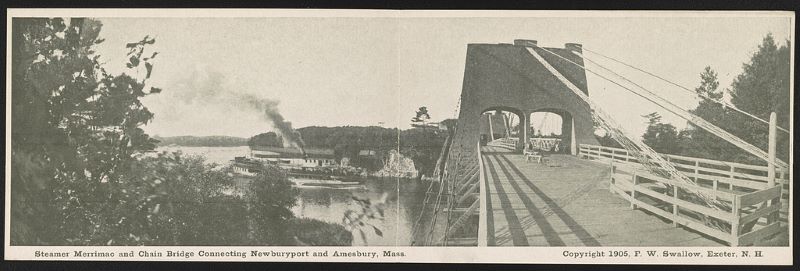
1910:
- The Albert Currier School, a Classic revival-style building, is built on Forrester Street.
- The Merrimac Street Railroad Bridge is built by the Boston & Maine Railroad on Merrimac Street.
- The New England Telephone Company Building is constructed on Green Street.
- The population of Newburyport is 14,949.
1912:
- The Newburyport Police Station, a Georgian Revival-style municipal building, is constructed on Green Street.
1915:
- Cashman Park is established on Merrimac Street.
- The Newburyport Building Association building is constructed on Merrimac Street. It later serves as a factory for the Ruth Shoe Company in 1938.
- The Newburyport Shellfish Company, a wooden clam shack, is constructed at 267 Water Street.
1917:
- The Balch – Bliss – Cashman Apartment House, an Italianate-style triple-decker apartment house, is built on Fair Street, making it one of the first apartment buildings in Newburyport.
- The Strand Theater, a Classical Revival-style theater building, is constructed on Green Street.
1920:
- The population of Newburyport is 15,618.
1922:
- The Saint Paul’s Episcopal Church, a Colonial Revival-style building, is constructed on High Street.
1925:
- Teenage vandals break into the Pierce family tomb at the Old Hill Burying Ground, remove the clothing from several corpses and wear the clothing while running around the Bartlett Mall where they are later arrested.
1927:
- The U.S. Post Office – Newburyport Main Branch, a Colonial Revival-style building, is constructed on Pleasant Street.
1928:
- The Newburyport Masonic Temple, a Classic Revival-style building, is constructed on Green Street.
- The Newburyport Five Cent Savings Bank, a Colonial Revival-style brick building, is constructed on State Street.
- The Joy Building, a commercial building, is constructed at 42-50 Inn Street after the previous building is destroyed in a fire in 1928.
- The S.S. Kresge Five and Dime Store, a Colonial Revival-style commercial building, is constructed on the corner of Pleasant Street and State Street and later becomes home to Richdale Convenience store in 1970.
- The First National Store building, a brick commercial building, is constructed at 82 State Street.
1929:
- The Chestnut Street Bridge is built on Chestnut Street.
- The Hancock Street Bridge is built on Hancock Street.
1930:
- The population of Newburyport is 15,084.
1933:
- The Newburyport World War I Memorial is erected on Pleasant Street.
1934:
- The High Street Bridge is built on High Street.
- The Washington Street Bridge is built on Washington Street.
- The “Million Dollar Fire” breaks out in downtown Newburyport and destroys both sides of Merrimac Street from Winter Street and Bridge Road to Titcomb Street.
- The Brown Jewelry Store, a single-story clapboard building, is constructed on Pleasant Street and later becomes homes to a pizza shop in 1995.
1937:
- The Newburyport High School is built on High Street.
1938:
- The Mayfair Shoe Company purchases the James Steam mills on Charles Street and owns it until 1954.
1940:
- The Immaculate Conception Convent is constructed on High Street.
- The Newburyport Daily News building is constructed on Liberty Street.
- The J.J. Newberry Five and Dime Store, a Colonial Revival-style commercial building, is constructed on Pleasant Street.
- The Newburyport A and P Store, a Colonial Revival-style brick commercial building, is constructed at 84 State Street.
- The population of Newburyport is 13,916.
1943:
- The First Church of Christ Science is built on High Street.
1948:
- Port Cinema, a moderne style building, is constructed on Pleasant Street.
1950:
- The Newburyport Spanish War Memorial is erected on Pleasant Street.
- The Wolfe Tavern on the corner of State Street and Harris Street is demolished.
- The population of Newburyport is 14,111.
1951:
- The Whittier Memorial Bridge, a steel truss bridge, is built on Route 95 as part of the Route 95 interstate system.
- The Newburyport War Memorial is erected at Atkinson Common on High Street.
1954:
- On February 13, Washington Hall at 47 State Street is destroyed in a fire.
- A Colonial Revival-style commercial building is built on the former site of Washington Hall and is later owned by Chase and Lunt Insurance in the 1970s.
1955:
- The Belleville School is built on High Street.
- The Immaculate Conception School is built at 1 Washington Street.
1956:
- The Newburyport Army National Guard Armory is constructed on Low Street.
1960:
- The population of Newburyport is 14,004.
1961:
- The First and Ocean Bank, a Colonial Revival-style brick building, is constructed on State Street.
1970:
- The population of Newburyport is 15,807.
1972:
- The old Route 1 Bridge is replaced by the Andrew J. Gillis Memorial Bridge.
- The Merrimack River Coast Guard Station is built on Water Street and the Newburyport Harbor Front Range Light is moved to the station.
1974:
- The Inn Street Pedestrian Mall is constructed on Inn Street.
1975:
- The Inn Street Mall Fountain is constructed on Inn Street.
1976:
- On July 2 at 3:38 am, the Newburyport Superior Courthouse on the Bartlett Mall is damaged when it is bombed by four members of the Fred Hampton Unit of the People’s Force, a domestic terrorist group. The bombing is a part of a series of four bombings that the group carry out that night on the seacoast.
1977:
- The Waterfront Promenade Park Marker is erected on Merrimac Street.
- In the summer, archaeologists excavate sections of Market Square, around the old Firehouse building and several spots near the riverbank, looking for the location of Watt’s cellar and the remains of a possible Native American village but are unable to locate either. They do uncover five arrowheads and around 20,000 early American artifacts.
1979:
- The Newburyport War Memorial, a granite obelisk dedicated to soldiers of all wars, is erected on Pleasant Street.
1980:
- The population of Newburyport is 15,900.
1985:
- In February, teenage vandals break into the Pierce family tomb at the Old Hill Burying Ground, remove the corpses from their coffins and sit them up while the vandals drink alcohol and pour alcohol into the corpse’s mouths.
- The Massachusetts Department of Environmental Management acquires the 450-acre Moseley estate on Curzon Mill Road and designates it a state park named Maudslay State Park.
1986:
- In February, the Bartlett Mall Swan Fountain collapses during an ice storm. The statue is removed so it can be repaired and refurbished.
1989:
- The United States Coast Guard Bicentennial Monument is erected on Water Street.
- In April, the Bartlett Mall Swan Fountain is reinstalled at the Frog Pond on the Bartlett Mall.
1990:
- The Old Market House at Market Square is rededicated as the Firehouse Center for the Arts.
- The population of Newburyport is 16,317.
2000:
- The population of Newburyport is 17,189.
2005:
- On August 17, a 19-year-old ordered to perform community service at the Old Burying Hill Cemetery breaks into the Pierce family tomb and removes the head of a corpse buried in the tomb, possibly Civil War soldier Willard Balch Pierce.
2010:
- The population of Newburyport is 17,416.
2020:
- The population of Newburyport is 18,289.
Sources:
Currier, John J. The History of Newburyport, Mass 1764 – 1905. Published by the author, 1906.
“MHC Reconnaissance Survey Town Report: Newburyport.” Massachusetts Historical Commission, 1985, file:///C:/Users/16039/Downloads/nwb.pdf
“The Shipyard at the Foot of Ashland Street” History Newburyport, historynewburyport.com/shipyard-ashland-street/
Macone, John. “Centuries later, Newburyport’s ‘Holy Grail’ keeps its secrets hidden.” Newburyport News, 23 April. 2007, newburyportnews.com/news/local_news/centuries-later-newburyport-s-holy-grail-keeps-its-secrets-hidden/article_31bfb5d2-fc1e-5baa-9d12-253c4f4e576d.html
“Historic 1893 Newburyport Train Station.” The Historical Marker Database, hmdb.org/m.asp?m=115590
“The 1873 Train Wreck Historical Marker.” The Historical Marker Database, hmdb.org/m.asp?m=115587
“Within Lie Buried.” The Historical Marker Database, hmdb.org/m.asp?m=115614
“The Bartlett Mall.” The Historical Marker Database, hmdb.org/m.asp?m=115536
“Dalton House.” The Historical Marker Database, hmdb.org/m.asp?m=49452
“Watt’s Cellar.” The Historical Marker Database, hmdb.org/m.asp?m=47985
“Market Square Tea Burning.” The Historical Marker Database, hmdb.org/m.asp?m=115416
Decosta-Kilpa, Nik. “41 Years Ago, 4 Bombings Swept Up the Seacoast from Boston to New Hampshire.” Boston.com, 2 July. 2017, boston.com/news/history/2017/07/02/41-years-ago-4-bombings-swept-up-the-seacoast-from-boston-to-new-hampshire/
“Rebecca Rawson.” History Newburyport, historynewburyport.com/rebecca-rawson/
“This 17th Century Newburyport House Must Be Saved.” The Daily News, 2 June. 2021, newburyportnews.com/opinion/editorials/editorial-this-17th-century-newburyport-house-must-be-saved/article_d0c45a59-d58a-5648-b858-d441565cf00e.html
Hendrickson, Dyke. “In Newburyport, Cemeteries Provide Glimpse Into City’s Colorful Past.” Newburyport Daily News, 18 Aug. 2014, newburyportnews.com/news/local_news/in-newburyport-cemeteries-provide-glimpse-into-citys-colorful-past/article_bb946230-dc53-5da0-9d1d-3fa7981804a8.html
Silva, Cristina. “Man, 19, Accused of Desecrating Civil War Corpse.” Boston.com, 25 Aug. 2005. archive.boston.com/news/local/articles/2005/08/25/man_19_accused_of_desecrating_civil_war_corpse/
“Historic Bridge Detail: NWB.900 Essex – Merrimac Bridge – Chain Bridge.” MACRIS, Massachusetts Culture Resource Information System, mhc-macris.net/#!/details?mhcid=NWB.900
MACRIS, Massachusetts Cultural Resource Information System, mhc-macris.net/


